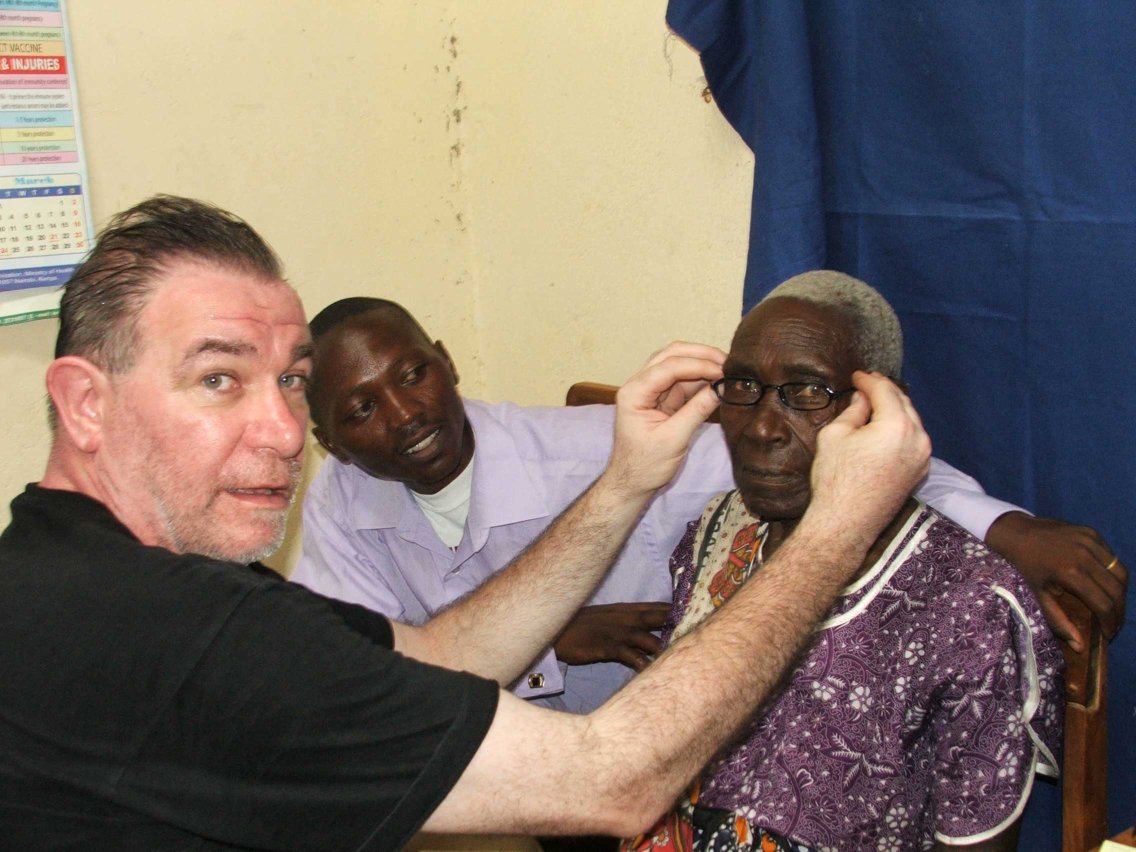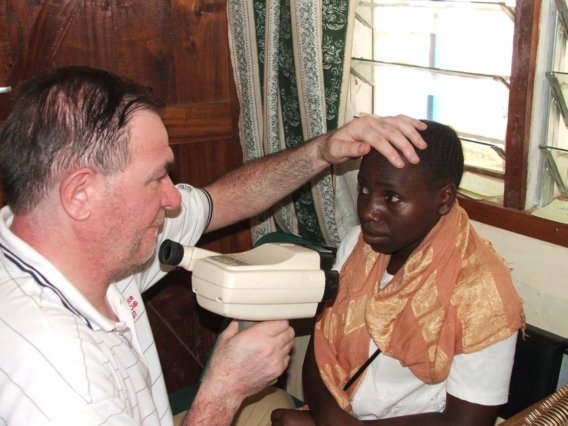Eye Testing In Rural From the Carlow Nationalist May/July 2009 © by Brendan Harding It had been a long, hot journey from Nairobi to the In previous years the parched landscape had left us wondering loudly how life could survive and even thrive in such conditions, but somehow it did. How the trees could support vast flocks of sunbirds and weavers, hornbills and bee-eaters, how ground squirrels could raise families and scamper in large groups across the murram road ahead of the oncoming vehicle. But this year the scene awaiting our arrival was greeted with silence and disbelief. How could if have gotten any worse? we asked ourselves quietly. The fat full frames of the baobab trees appeared to have aged rapidly, shrivelled and dried, their wide trunks hanging with bark which sagged like old decrepit skin. Their branches bare except for the tubular wooden beehives lodged in their towering arms, reminders of better times, of sweeter times. Even the thick, green, thorn bushes that survive when all else fails seemed now to wilt and prostrate themselves on the hot dry earth. It was clear that once again, for the third consecutive year, the rains had failed to arrive bringing famine in its wake.
As we neared our goal a young goatherd seemed to emphasise the point; he stood dressed in rags in the meagre shade of an acacia tree, his charge of usually busy foraging animals looked slow, emaciated and raw-boned. Unusually, the boy did not return the waves of the passing strangers, his young eyes were dull and jaundiced, his matt skin covered in a film of red dust. The evidence of the disaster continued to mount as we rounded the final bend into the village. The roads, so normally full of chattering people busy with their lives were empty and dustblown. There were no running children keeping pace with the arriving jeep, no women beating the backs of stubborn mules laden with water on the return trip from the well. The one solitary shadetree in the village square was skeletal and bare of leaves, beneath it, the seat where old men gather to tell old men’s stories was abandoned and broken.
The jeep stopped in the grounds of the Mercy compound rising a pall of dust. Waiting once again were the faces of old friends, their arms outstretched even before the sound of the engine had died. The nuns and their staff gathered at the back door to welcome us; unlike the fancy and monstrously-priced hotels of Nairobi city, in their hands there were no hot towels or cold drinks to greet the arriving guests, but instead they wore wide genuine smiles which immediately reminded us of the work we were about to undertake. * * * * “Karibuni.” they called, “welcome to you all.” We embraced and spoke rapidly of the journey now behind us. “Praise the Lord for your safe arrival,” Sister Bernadette the ever-cheerful Kenyan nun gushed with the eagerness of a child, “now, come inside, it is so hot and we have much to plan and much to talk about.” And she was right, over a long and welcoming dinner in the nuns’ humble surroundings plans were made for our every movement. The names of the villages were listed; Kavindu, Wingemi, Mwambiu, Nyaani and our usual clinic here in the Next morning we arrived in the Last time in Kavindu I had written a story about the weaver birds clambering in the green tree tops, about their noise and bustle, about their flashing golden plumage, about their straw nests which hung like Christmas tree baubles. Now there were none and the trees were bare, the shredded remnants of last year’s nests drooped in the empty branches. Across the countryside there was no bird song except for the occasional screeching call from a lone augur buzzard. Even the cicadas were silent.
But the people had come and waited patiently in what little shade they could find. It was a baptism of fire in the most literal sense for Jim our new colleague. He had been suffering from a chest infection and the conditions inside a tin-roofed building one degree from the equator was not exactly what the doctor had ordered. Still, he carried on testing the seemingly endless line of people who waited throughout the day. By day’s end both opticians had treated onehundred and three people, twenty-four of whom would make the hard journey to Nairobi by bus where their cataracts would be removed and their lives would begin afresh. It was a good day. We drove home as the Sun sat low on the surrounding hills washing the volcanic landscape in a soft and gentle pink glow. An eagle spun in tireless circles over the village. On my first visit here I would have gushed in amazement at the sights around me, but now I sat silent in the back seat of the jeep, smiling contentedly at the work that at been performed on this first day.
Eye Testing In Rural From the Carlow Nationalist May/July 2007 © by Brendan Harding Arriving at the clinic
in Wingemi a large grey and white bird screamed from the topmost branch of a
thorn bush. ‘Go away! Go away!’ it called; the opticians, unloading the jeep
and preparing for the day which lay ahead payed it no attention. I
had heard the call of the White-bellied goaway- bird before but this was my
first time to see one – in the feathers, so to speak. He stood perched high on
his pedestal surveying the vast and arid landscape surrounding his home
territory. From blue mountains to blue mountains he watched everything that
moved. He watched as the thin children led their flocks out into the bush, as
the haggard women drove their mules many miles to the well and as the sick and
dying were laid outside their homes to breathe the fresh morning air. A lavish
plume of slate-grey feathers rose stiffly from his crown and his long,
out-of-proportion tail bobbed like a conductor’s baton. ‘Go away!’ he screamed
once again at the line of tired-looking people appearing slowly through the
gates of this remote and rural clinic. The
people – unlike the noisy resident of the thorn tree – were silent as they
dragged their weary feet through the thick red dust of Eastern Kenya. It was only at their
journey’s end, as they reached the shelter of the tired government building did
they once again become animated; shaking hands with friends, touching the faces
of the elderly and recounting tales of their journey and their hard lives.
Throughout the day the people came in ones and twos. Their stories linked by a common
thread – that thread, the hope of a better life, an easier life. In
Wingemi village the waiting people were mostly old, a testament to the fact of
how the younger members of each community had been forced to travel to distant
towns and cities in an effort to make the dream of that better life come true.
In the slums of Nairobi and Thika, Mwingi and Machakos they shared tiny houses
made from whatever material that came to hand; corrugated metal for the lucky
ones; cardboard and flattened oil drums for the others. They eked an existence
for themselves and for those at home by picking their way through the refuse of
others; competing with the ever-present flocks of gulls and black kites. They
stood knee deep in the filth of their countrymen as ugly, wattlenecked Marabou
storks watched over them like undertakers at a funeral. Others
had gone to the city in search of glory only to be swallowed up in its bowels,
never to be heard from again. Like the painted girls who sat at the bars every evening
in every hotel, smiling at every man who walked into the room. After this there
was no way home again. But
the ones who remained waited throughout the day with patience and dignity.
Eventually, when their turn arrived they were welcomed by the smiling faces and
ever-open arms of Sisters Goretti and Bernadette. Ushered with compassionate
whispers they were led into the clinic where the opticians took their time and
allayed their fears before conducting each test in the soaring heat as if it
were the first and only one of the day. At ease the peoples’ nervous faces
turned to smiles, laughter and even the occasional song. These songs were seen
as a form of payment for the work of the Wazungu - the white men who had
come to help them. Over
the following days the clinics continued; the opticians pushed to their very
limits in primitive conditions where furnace-like was the norm. Firstly in the But
the negatives were overshadowed by the results obtained. By the end of the
clinics the tally of patients who had been examined came to 403 individuals,
and from these over 100 would travel to Nairobi where they would be further evaluated
and eventually treated under the care of Dr Walia in the pristine and efficient
Since
the team’s first contact with the hospital back in 2007 a viable and
flourishing link has been formed and now constitutes a ready assembly line of
patients for the waiting surgeons. Because of the unselfish nature of the
opticians, the hospital staff, the Mercy nuns and so many others who have given
generously from their lives and their pockets, project On
our final night in Nuu we sat on the verandah of the convent assessing the work
that had been done and allowing the cool taste of Tusker beer to wash away the
dust of the countryside from our throats. In the sky above the far off Tana
hills a full, butter-coloured moon traversed the cloudless sky and despite the
sheer beauty of the scene we were now a little more humble and a little more
aware of the conditions being suffered by those who call this home. How so many
still died from famine, AIDS, malaria, measles, sleeping sickness and so many
afflictions which we read about in the pages of newspapers from the comfort of
our homes. We were also aware of the many who would never witness these sights;
but still through the goodness that lives within them they reach deep into
their pockets and their hearts when it is asked of them to help the suffering
of those they will never know. To them we once again say, thank you – |
PICTURE GALLERY     |